-
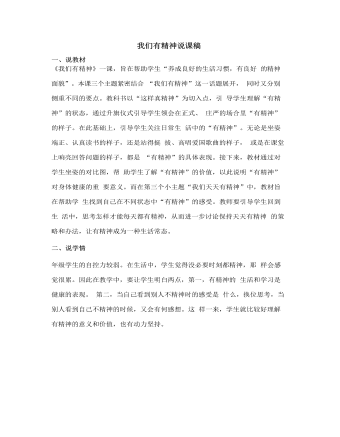
人教部编版道德与法制一年级下册我们有精神说课稿
一、说教材《我们有精神》一课,旨在帮助学生“养成良好的生活习惯,有良好 的精神面貌”。本课三个主题紧密结合 “我们有精神” 这一话题展开, 同时又分别侧重不同的要点。教科书以“这样真精神”为切入点,引 导学生理解“有精神”的状态,通过升旗仪式引导学生领会在正式、 庄严的场合里“有精神”的样子。在此基础上,引导学生关注日常生 活中的“有精神”。无论是坐姿端正、认真读书的样子,还是站得挺 拔、高唱爱国歌曲的样子, 或是在课堂上响亮回答问题的样子,都是 “有精神”的具体表现。接下来,教材通过对学生坐姿的对比图,帮 助学生了解“有精神”的价值,以此说明“有精神”对身体健康的重 要意义。而在第三个小主题“我们天天有精神”中,教材旨在帮助学 生找到自己在不同状态中“有精神”的感受。教师要引导学生回到生 活中,思考怎样才能每天都有精神,从而进一步讨论保持天天有精神 的策略和办法,让有精神成为一种生活常态。
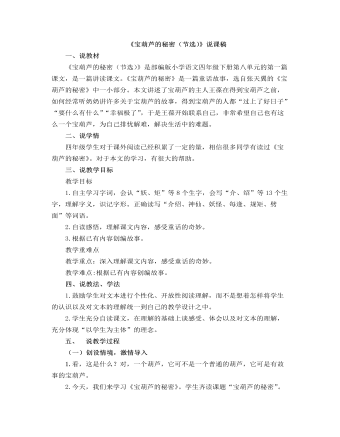
部编人教版四年级下册《 宝葫芦的秘密(节选)》说课稿
三、说教学目标教学目标1.自主学习字词,会认“妖、矩”等8个生字,会写“介、绍”等13个生字,理解字义,识记字形。正确读写“介绍、神仙、妖怪、每逢、规矩、劈面”等词语。2.自读感悟,理解课文内容,感受童话的奇妙。3.根据已有内容创编故事。教学重难点教学重点:深入理解课文内容,感受童话的奇妙。教学难点:根据已有内容创编故事。四、说教法、学法1.鼓励学生对文本进行个性化、开放性阅读理解,而不是想着怎样将学生的认识以及对文本的理解统一到自己的教学设计之中。2.学生充分自读课文,在理解的基础上谈感受、体会以及对文本的理解,充分体现“以学生为主体”的理念。
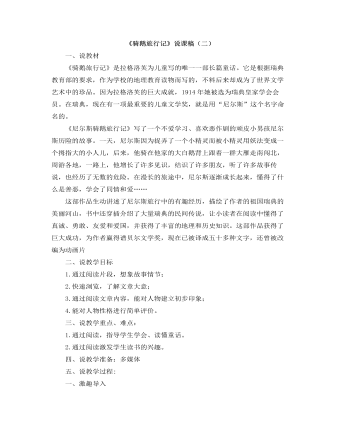
部编人教版六年级下册《骑鹅旅行记(节选)》说课稿(二)
一、说教材《骑鹅旅行记》是拉格洛芙为儿童写的唯一一部长篇童话。它是根据瑞典教育部的要求,作为学校的地理教育读物而写的,不料后来却成为了世界文学艺术中的珍品。因为拉格洛芙的巨大成就,1914年她被选为瑞典皇家学会会员。在瑞典,现在有一项最重要的儿童文学奖,就是用“尼尔斯”这个名字命名的。《尼尔斯骑鹅旅行记》写了一个不爱学习、喜欢恶作剧的顽皮小男孩尼尔斯历险的故事。一天,尼尔斯因为捉弄了一个小精灵而被小精灵用妖法变成一个拇指大的小人儿,后来,他骑在他家的大白鹅背上跟着一群大雁走南闯北,周游各地,一路上,他增长了许多见识,结识了许多朋友,听了许多故事传说,也经历了无数的危险。在漫长的旅途中,尼尔斯逐渐成长起来,懂得了什么是善恶,学会了同情和爱……
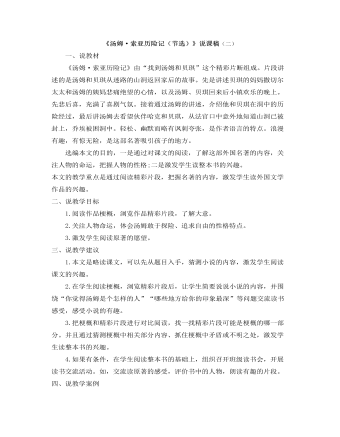
部编人教版六年级下册《汤姆·索亚历险记(节选)》说课稿(二)
一、说教材 《汤姆·索亚历险记》由“找到汤姆和贝琪”这个精彩片断组成。片段讲述的是汤姆和贝琪从迷路的山洞返回家后的故事。先是讲述贝琪的妈妈撒切尔太太和汤姆的姨妈悲痛绝望的心情,以及汤姆、贝琪回来后小镇欢乐的晚上。先悲后喜,充满了喜剧气氛。接着通过汤姆的讲述,介绍他和贝琪在洞中的历险经过,最后讲汤姆去看望伙伴哈克和贝琪,从法官口中意外地知道山洞已被封上,乔埃被困洞中。轻松、幽默而略有讽刺夸张,是作者语言的特点。浪漫有趣,有惊无险,是这部名著吸引孩子的地方。 选编本文的目的,一是通过对课文的阅读,了解这部外国名著的内容,关注人物的命运,把握人物的性格;二是激发学生读整本书的兴趣。 本文的教学重点是通过阅读精彩片段,把握名著的内容,激发学生读外国文学作品的兴趣。
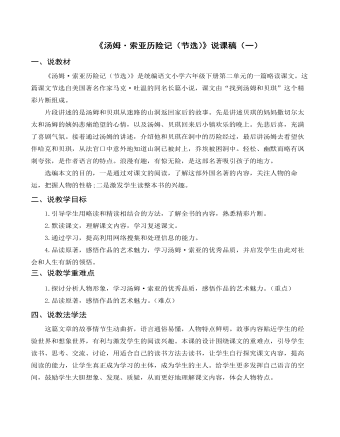
部编人教版六年级下册《汤姆·索亚历险记(节选)》说课稿(一)
一、说教材《汤姆·索亚历险记(节选)》是统编语文小学六年级下册第二单元的一篇略读课文。这篇课文节选自美国著名作家马克·吐温的同名长篇小说,课文由“找到汤姆和贝琪”这个精彩片断组成。 片段讲述的是汤姆和贝琪从迷路的山洞返回家后的故事。先是讲述贝琪的妈妈撒切尔太太和汤姆的姨妈悲痛绝望的心情,以及汤姆、贝琪回来后小镇欢乐的晚上。先悲后喜,充满了喜剧气氛。接着通过汤姆的讲述,介绍他和贝琪在洞中的历险经过,最后讲汤姆去看望伙伴哈克和贝琪,从法官口中意外地知道山洞已被封上,乔埃被困洞中。轻松、幽默而略有讽刺夸张,是作者语言的特点。浪漫有趣,有惊无险,是这部名著吸引孩子的地方。 选编本文的目的,一是通过对课文的阅读,了解这部外国名著的内容,关注人物的命运,把握人物的性格;二是激发学生读整本书的兴趣。
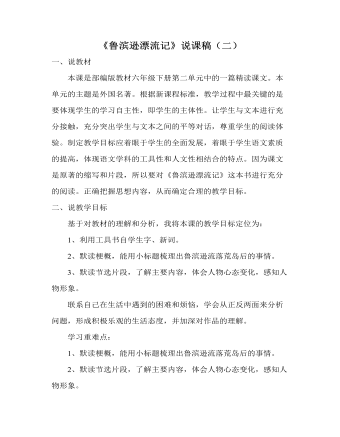
部编人教版六年级下册《鲁滨逊漂流记(节选)》说课稿(二)
四、说学法学生是学习的主体。皮亚杰认为,在教学过程中,儿童如果不具有自己的意象活动教育就不能成功。1、整体感知,初步了解课文的大概内容。学生先自读课文。自学完以后,概括出文章的主要内容。这样,学生就会从整体上知道这篇课文讲的是什么内容。2、充分自学。人的大脑接受信息,有意注意总比无意注意有效得多。本课内容浅显易懂,可以充分放手让学生自学,经过自学,学生对课文有了一个大概了解,有了一番摸索的功夫,或者是略有解悟,或者是不得要领,或者是困惑不解。一旦进入探讨阶段就会全身心投入。一方面可以从容、有条不紊地发表自己的见解;另一方面略有所悟的急需得以印证和深化,不得要领的急需理清头绪,困惑不解的急需弄个明白,自然都格外注意,毫不懈怠。这样既提高了学习兴趣,又留下了深刻印象,还强化了自主意识。
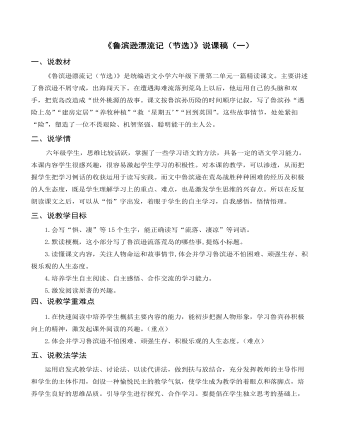
部编人教版六年级下册《鲁滨逊漂流记(节选)》说课稿(一)
一、说教材《鲁滨逊漂流记(节选)》是统编语文小学六年级下册第二单元一篇精读课文。主要讲述了鲁滨逊不屑守成,出海闯天下。在遭遇海难流落到荒岛上以后,他运用自己的头脑和双手,把荒岛改造成“世外桃源的故事。课文按鲁滨孙历险的时间顺序记叙,写了鲁滨孙“遇险上岛”“建房定居”“养牧种植”“救‘星期五’”“回到英国”。这些故事情节,处处紧扣“险”,塑造了一位不畏艰险、机智坚强、聪明能干的主人公。二、说学情六年级学生,思维比较活跃,掌握了一些学习语文的方法,具备一定的语文学习能力。本课内容学生很感兴趣,很容易激起学生学习的积极性。对本课的教学,可以渗透,从而把握学生把学习例话的收获运用于读写实践。而文中鲁滨逊在荒岛战胜种种困难的经历及积极的人生态度,既是学生理解学习上的重点、难点,也是激发学生思维的兴奋点。所以在反复朗读课文之后,可以从“悟”字出发,着眼于学生的自主学习,自我感悟,悟情悟理。
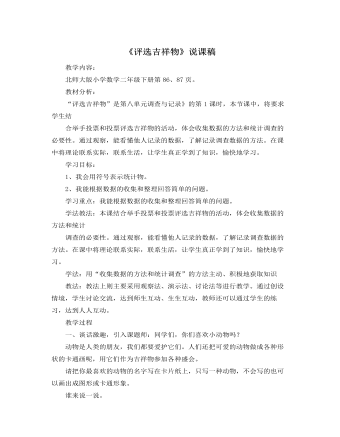
北师大版小学数学二年级下册《评选吉祥物》说课稿
教学过程一、谈话激趣,引入课题师:同学们,你们喜欢小动物吗?动物是人类的朋友,我们都要爱护它们。人们还把可爱的动物做成各种形状的卡通画呢,用它们作为吉祥物参加各种盛会。请把你最喜欢的动物的名字写在卡片纸上,只写一种动物,不会写的也可以画出成图形或卡通形象。谁来说一说。同学们的盛会是六一节,学校准备把同学们最喜欢的动物作为吉祥物布置到校园。该把哪种动物作为吉祥物呢?怎样才知道哪种动物是同学们最喜爱的动物呢?师:对没有调查就没有发言权,调查一下哪种动物最受我们喜欢就行了。用什么方法才能知道喜欢某种动物的人最多呢?请小组讨论下该怎样调查呢?把详细的过程说出来。二、小组合作,探究新知1、说一说,你们组准备怎样开展调查生1:我们让喜欢某种小动物的同学举手。查一查人数就行了。
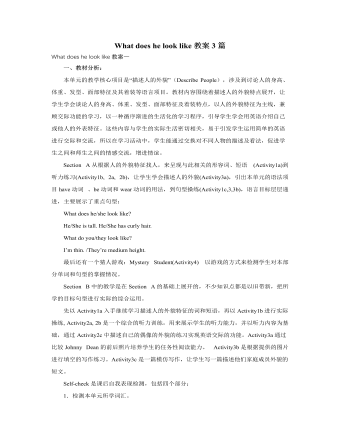
人教版新目标初中英语七年级下册What does he look like教案3篇
所需要用到的句子:Who is that?That is Jack. I like him.Why do you like him?I like him because he is interesting.Task 4: 设计理想中的人类Step one: 设计理想中的人类的外貌。把全班同学分成若干小组,学生可以边说边在纸上画出他们的模样。Step two: 设计理想中人类的性格。学生们可以把那些能描述性格的单词写在图画的旁边。Step three: 每组选出一名同学,其他同组同学提问,他作简单回答,并说明原因。所需用到的句子:What does he or she look like?He or she ...What is he or she like?He or she is ...Why?Because ...Task 5: 挑战性活动调查性格是天生的还是后天形成的,让每个同学回家去调查一下自己成长过程中性格是否有变化,具体是怎样的,为什么会这样? Teaching Aims:1. Enable students to have a general understanding of how to talk about people's physical appearance.2. Enable students to tackle some essential vocabularies and patterns about describing people. Provide them with necessary skills and methods.3. Create various chances for students to describe the persons they're familiar with, such as classmates, family members, teachers, idols, etc.
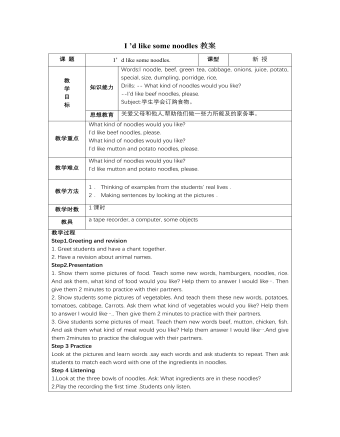
人教版新目标初中英语七年级下册I ’d like some noodles教案
教学过程Step 1: warming-up Sing a song---------“food and drink” Step 2: Revision1 Dictation2 Revise: What kind of noodles would you like?I’d like …What size bowl of noodles would you like?I’d like…Step 3: Presentation1 show pictures of food, ask students say the words.2 Students read the newspaper ad in 3a. Fill in blanks with words in the box. Then read the ad together, the teacher explains some difficult language points.3 Check the answers Step 4 PracticeAsk students to finish 3b in the same way according to 3a. Students read the short passage and fill in the blanks .At last, check the answers.Step 5 productionAsk students to write their own ad for dumplings, noodles, drinks, and other foods they know. Then ask students to read their partner’s ad. Then order food and drink from their partner.Step 6 Home workGroup work – make an ad about “food and drink”
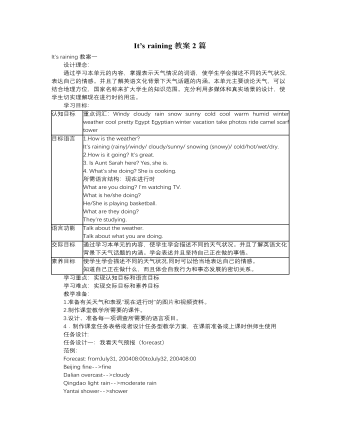
人教版新目标初中英语七年级下册It’s raining教案2篇
1 Each group choose one place to describe and what you are doing in it Choose one place, and describe what they are doing 2 Move around the room and give suggestions Talk about it and write it down 3 Ask one to show their works and act it Choose one of each group to make a report 4 Evaluate the best group and the best reporter Choose the best one Homework Ask your friends their ideal place and write about it教学反思:新课程标准中强调学生在课堂中的主体地位,在综合课中他们的主体地位就更加突出。在各个活动中给不同程度的学生不同层次的任务,让各层面的学生都有表现发挥的机会,从而产生对英语的兴趣。使用照片图片多媒体来辅助教学,效果更好。同时让了解其他国家风景,风俗的同学介绍ideal place,增加学生的背景知知识,实现跨学科交流的目的。教案点评:采用任务型教学模式,在各个活动中给不同程度的学生不同层次的任务,让各层面的学生都有表现发挥的机会,从而产生对英语的兴趣。使用照片图片多媒体来辅助教学,效果更好。让了解其他国家风景,风俗的同学介绍ideal place,增加学生的背景知识,实现跨学科交流的目的。
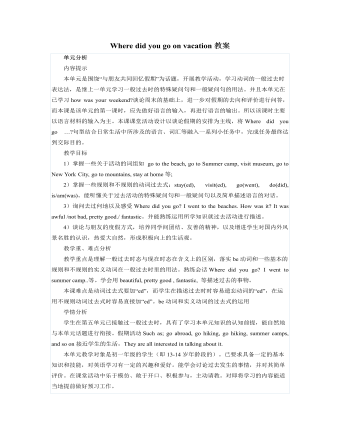
人教版新目标初中英语七年级下册Where did you go on vacation教案
句型: Where did you go on vacation? I went to summer camp.Did she go to Central Park?Yes,she did.No, she didn’t语法:一般过去时特殊疑问句、一般疑问句及肯、否定回答。课时安排4课时第一课时:Section A:la,1b,lc,2a,2b,2c 第二课时:Section A:3a,3b,4第三课时:Section B:1,2a,2b,2c第四课时:Section B:3a,3b,3c,4 and Self Check第一课时教学目标掌握描写假期生活的形容词。假期里自己所做事情的简单表达。谈论假期做的事情及当时情况。谈论假期时旅游的天气,旅游者以及食物等。教学过程一、导入播放一首英文歌曲:Let’s travel 说明:通过让学生听节奏欢快迪斯尼英语歌曲Let’s travel.引入本节课谈论的话题vacation and travel. 让歌曲使学生的思维活跃,增强课堂气氛,激发学生提高学习英语的兴趣。T:How is the trip ?Ss : It’s pretty good/ happy/exciting /relaxing/busy/dangerous/ fantastic说明:这个问题是为了操练形容词。建议让多个Ss作答。鼓励他们用不同的形容词。上述个别形容词本应在第二课时中出现,但可以在warming-up中第一次非正式出现。这些形容词也可在老师的评价语中适时出现,以加深学生对词汇的印象。
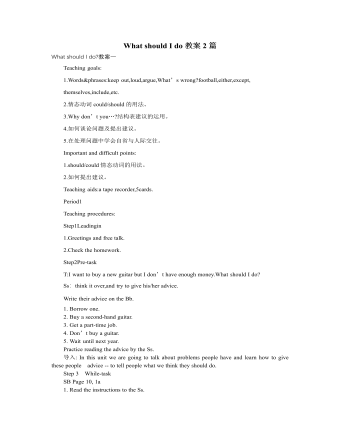
人教版新目标初中英语八年级下册What should I do教案2篇
说明:在帮Li Lei提建议的同时,教育学生如何学好英语。第三课时教学目标1. 语言目标:a) 词汇: Original, in style, haircut, the same as.b) 语言结构:My friend wears the same clothes and has the same haircut as I do.2. 能力目标:大多数学生能够谈论自己喜欢哪种服装,提高查找信息的能力。3. 情感目标:学会如何与朋友相处,要有自己对时尚的看法。教学重点掌握一些重要词汇。教学难点学会谈论问题,并能提出书面建议。◆教学突破首先针对Erin的问题,提出个人的建议,模仿2c部分的对话展开双人交际Pair-work;听老师诵读3a部分的信件,并找出LEFT OUT的问题所在;学生完成3b部分的内容,给Left Out提出书面的建议;学以口头形式提出自己目前存在的某个问题,讲给大家听,让同学们给自己提出一个建议,并作笔录;学生两、三个人分成一组,随意性地进行口语交际,谈论P14的第4部分的某个问题,相互交换意见。
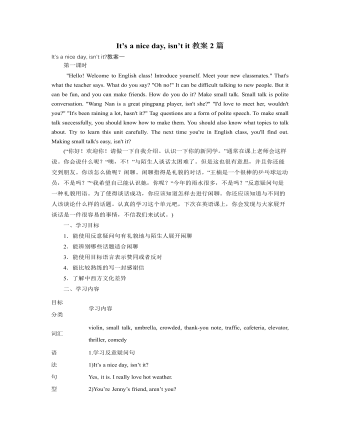
人教版新目标初中英语八年级下册It’s a nice day, isn’t it教案2篇
"Hello! Welcome to English class! Introduce yourself. Meet your new classmates." That's what the teacher says. What do you say? "Oh no!" It can be difficult talking to new people. But it can be fun, and you can make friends. How do you do it? Make small talk. Small talk is polite conversation. "Wang Nan is a great pingpang player, isn't she?" "I'd love to meet her, wouldn't you?" "It's been raining a lot, hasn't it?" Tag questions are a form of polite speech. To make small talk successfully, you should know how to make them. You should also know what topics to talk about. Try to learn this unit carefully. The next time you're in English class, you'll find out. Making small talk's easy, isn't it? (“你好!欢迎你!请做一下自我介绍。认识一下你的新同学。”通常在课上老师会这样说。你会说什么呢?“噢,不!”与陌生人谈话太困难了。但是这也很有意思,并且你还能交到朋友。你该怎么做呢?闲聊。闲聊指得是礼貌的对话。“王楠是一个很棒的乒乓球运动员,不是吗?”“我希望自己能认识她,你呢?“今年的雨水很多,不是吗?”反意疑问句是一种礼貌用语。为了使得谈话成功,你应该知道怎样去进行闲聊。你还应该知道与不同的人该谈论什么样的话题。认真的学习这个单元吧,下次在英语课上,你会发现与大家展开谈话是一件很容易的事情,不信我们来试试。)
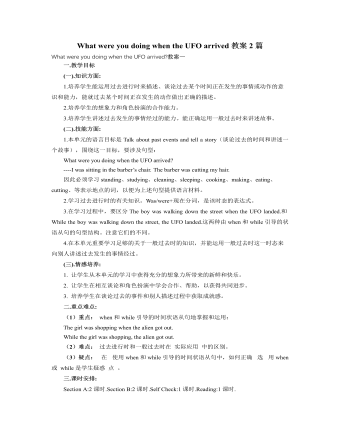
人教版新目标初中英语八年级下册What were you doing when the UFO arrived教案2篇
(一).知识方面: 1.培养学生能运用过去进行时来描述、谈论过去某个时间正在发生的事情或动作的意识和能力,能就过去某个时间正在发生的动作做出正确的描述。 2.培养学生的想象力和角色扮演的合作能力。 3.培养学生讲述过去发生的事情经过的能力。能正确运用一般过去时来讲述故事。 (二).技能方面: 1.本单元的语言目标是Talk about past events and tell a story(谈论过去的时间和讲述一个故事),围绕这一目标,要涉及句型: What were you doing when the UFO arrived? ----I was sitting in the barber’s chair. The barber was cutting my hair. 因此必须学习standing、studying、cleaning、sleeping、cooking、making、eating、cutting、等表示地点的词,以便为上述句型提供语言材料。2.学习过去进行时的有关知识。Was/were+现在分词,是该时态的表达式。 3.在学习过程中,要区分The boy was walking down the street when the UFO landed.和While the boy was walking down the street, the UFO landed.这两种由when和while引导的状语从句的句型结构。注意它们的不同。
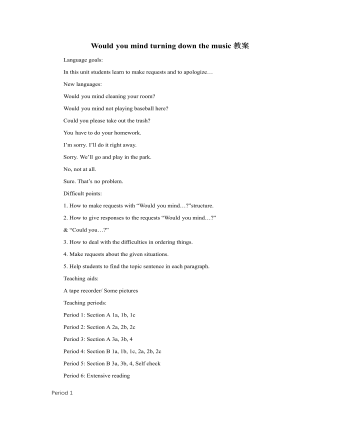
人教版新目标初中英语八年级下册Would you mind turning down the music教案
Step 4. Group work (4)1. Ask a pair of students to read the dialogue. Say, This activity provides speaking, listening and writing practice using the target language.2. Ask students to complete the work in groups.3. Check the answers with the whole class. 4. Explain some of the language points. Step 5. Word review (Self check 1)1. Ask students to read the words and the phrases given. 2. Fill in the blanks with proper forms of these words to complete the sentences. 3. Check the answers with the whole class. Homework:Do activity 2 on page 57 after class. Period 6Teaching aims: 1. Teach vocabulary words and the useful expressions. 2. Enable the students to learn etiquette in different culture. 3. Help the students learn how to behave politely in public places and in daily life. Teaching procedures:Step 1. RevisionHelp students to review the function of making requests through a free talk. Then lead them to the topic of etiquette. Explain the meaning of etiquette. Or, ask students to look it up in the dictionary. Step 2. Pre-reading (Section 1)1. Ask students to read the picture and make a list with their partner about how many rules of etiquette can be seen being broken.
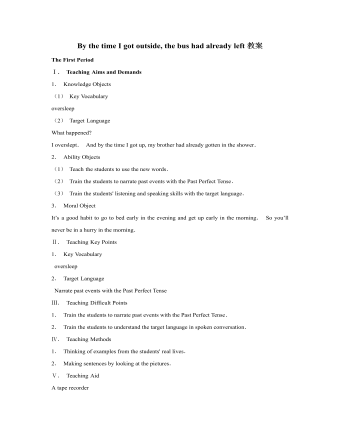
人教版新目标初中英语九年级下册By the time I got outside, the bus had already left教案
Ⅰ. Teaching Aims and Demands1. Knowledge Objects(1) Key Vocabularyoversleep(2) Target LanguageWhat happened?I overslept. And by the time I got up, my brother had already gotten in the shower.2. Ability Objects(1) Teach the students to use the new words.(2) Train the students to narrate past events with the Past Perfect Tense.(3) Train the students' listening and speaking skills with the target language.3. Moral ObjectIt’s a good habit to go to bed early in the evening and get up early in the morning. So you’ll never be in a hurry in the morning.Ⅱ. Teaching Key Points1. Key Vocabularyoversleep2. Target LanguageNarrate past events with the Past Perfect TenseⅢ. Teaching Difficult Points1. Train the students to narrate past events with the Past Perfect Tense.2. Train the students to understand the target language in spoken conversation.Ⅳ. Teaching Methods1. Thinking of examples from the students' real lives.2. Making sentences by looking at the pictures.Ⅴ. Teaching AidA tape recorderⅥ. Teaching ProceduresStep I Revision1. Revise the language points in Unit 8.Ask some questions like this: What volunteer work would you like to do?Help the students to answer, I’d like to…/I love to…/I hope to2. Practice the dialogue in Activity 3c on page 62 again. Get students to role play the similar dialogues with the following.
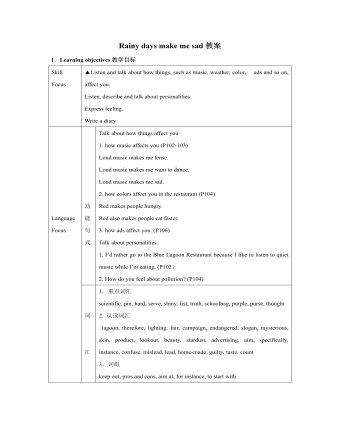
人教版新目标初中英语九年级下册Rainy days make me sad教案
1. 教材分析本单元以how do things affect you?为话题, 从颜色、天气、音乐、广告、产品等方面谈论了外界事物如何影响人的心情。要求学生掌握表达某物或某事给人带来的感觉、看法或影响等。共设计了四个部分的内容:Section A 该部分有4个模块:第一模块围绕Which restaurant would you like to go to?这一话题展开思维(1a)、听力(1b)、口语(1c)训练;第二模块围绕How does music affect you? 进行听力(2a-2b)、口语训练(2c);第三模块继续围绕how do colors in the restaurant affect you这一话题展开训练,训练形式为阅读和问题体验(3a)和小组活动(3b);第四模块仍就How do things affect you这一话题以调查的形式展开讨论。Section B该部分有4个模块:第一模块围绕产品广告对人们的影响这一话题以“配对”(1a)与“列举”(1b)两种形式展开训练;第二模块继续围绕How do things affect you? 进行听力(2a-2b)、口语对话训练(2c);第三模块围绕“Advertising”这一话题展开阅读(3a-3b)和写作(3c)训练;第四模块围绕How posters affect you这一话题以口语训练形式展开小组活动。
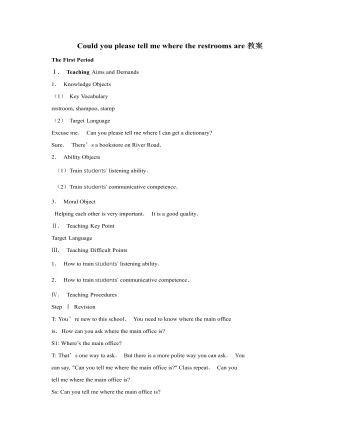
人教版新目标初中英语九年级下册Could you please tell me where the restrooms are教案
Step Ⅰ RevisionCheck homework. Ask a few students to read the article in 3a.Then ask a few students to read their guides.Step Ⅱ Part 1Look at the words in the box. Ask a student to read them. Make sure the students understand the meaning of the words. You are to fill in the blanks with the words. In some cases, students may need to use another form of the word, for example adjusting for tense or subject/ verb agreement.Ask students to fill in the blanks on their own.Check the answers. Step ⅢPart 2Go through the instructions with the class.Look at the example with the students.Ask students what the answer would be.Ask a student to read the question and answer it.Excuse me, could you tell me where the bank is, please?The bank is across the street from the shopping malt.Get students to complete the work in pairs.Check the answers. Ask a few students to read their questions.Step Ⅳ Just for Fun!Ask all the students to read the conversation. Ask: What is funny about this cartoon? Help students to explain. A Martian is a person from the planet Mars.There is no such thing as Martian food on Earth, and the clerk looks silly because he is trying to think of where there is a Martian restaurant.Invite some pairs of students to present this conversation to the rest of the class.Step Ⅴ Summary and HomeworkIn this class, we’ve done much writing practice using the key vocabulary words and the target language presented in this unit. After class, please finish the questions in 2 in your exercise books. Then finish the exercises on pages 47~48 of the workbook as well.The Seventh Period Ⅰ Teaching Aims and Demands1. Knowledge Objects(1) Key Vocabularyimage, adventure, jealousy, hero, crime, journey, brave, no longer, show interest in, take it easy, become interested in, plain looks(2)Text:Grown-ups like cartoons, too.2. Ability Objects(1) Fast-reading to get a general idea of the text.(2) Careful-reading to get the detailed information in the text.

初中历史与社会人教版九年级下册《地球一小时 活动》教材教案
地球一小时(Earth Hour)是世界自然基金会(WWF)应对全球气候变化所提出的一项倡议,希望家庭及商界用户关上不必要的电灯及耗电产品一小时。来表明他们对应对气候变化行动的支持。过量二氧化碳排放导致的气候变化目前已经极大地威胁到地球上人类的生存。公众只有通过改变全球民众对于二氧化碳排放的态度,才能减轻这一威胁对世界造成的影响。地球一小时在3月的最后一个星期六20:30~21:30期间熄灯。活动由来:“地球1小时”也称“关灯一小时”,是世界自然基金会在2007年向全球发出的一项倡议:呼吁个人、社区、企业和政府在每年三月最后一个星期六20:30~21:30期间熄灯1小时,以此来激发人们对保护地球的责任感,以及对气候变化等环境问题的思考,表明对全球共同抵御气候变暖行动的支持。这是一项全球性的活动,世界自然基金会于2007年首次在悉尼倡导之后,以惊人的速度席卷全球,大家都来参加这个活动。[1] “地球1小时”活动首次于2007年3月31日在澳大利亚的悉尼展开,一下子吸引了超过220万悉尼家庭和企业参加;随后,该活动以惊人的速度迅速席卷全球。在2008年,WWF(中国)对外联络处透露,全球已经有超过80个国家、大约1000座城市加入活动。2013年,包括悉尼歌剧院、帝国大厦、东京塔、迪拜塔、白金汉宫在内的各国标志性建筑也在当地时间晚八点半熄灯一小时。[2] ,其中包括巴勒斯坦、法属圭亚那、加拉帕戈斯群岛、卢旺达、圣赫勒那岛、苏里南、突尼斯等首次参与“地球一小时”的国家和地区。在中国,北京鸟巢、水立方、世贸天阶等标志性建筑同时熄灯,同一时段,从上海东方明珠到武汉黄鹤楼,从台北101到香港天际100观景台,中国各地多个标志性建筑均熄灯一小时,全国共有127个城市加入“地球一小时”活动。

